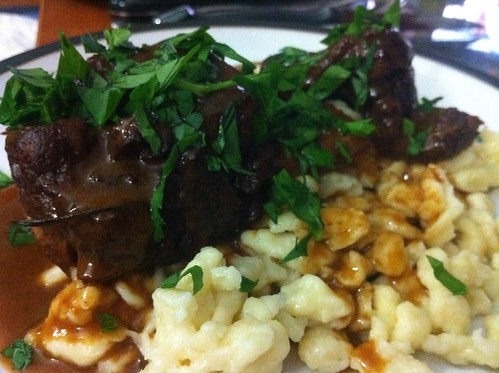As I start this chapter on the cuisines of Europe, I start to see a trend. Cuisines are inevitably influenced by their surroundings, and while the European are known for bringing ingredients to the new world, the old-time cuisines are influenced by each other as well. For example, the southeast region of France shows heavy Mediterranean influences in cuisine, while the Northeast region reflects a lot of Germany's mainstays like sauerkraut and spaetzle. When the Romans took the area over in 56 BC, they introduced cheese-making, something France remains famous for to this day! Today, Grande Cuisine is what we use to classify modern-day French cuisine. This emerged after the marriage of Catherine de Medici, of Italy, to Henry II. She essentially introduced gastronomy to the French culture!
The Northern region of Italy lies in the Alps, where the pastures are ideal for raising livestock, leading to a cuisine laden with heavy meat dishes. It also leads to a large production of milk, butter and farm-fresh cheeses. Of course, Piemonte is one of the largest producers of rice, which means risotto is a staple of this region as well. In Central Italy, where the land is lush with vineyards and olive groves, olive oil is the preferred fat used for cooking. Little else, aside from herbs, is needed for the simple preparations of food that this region is accustomed to. Did you know that the first culinary school was founded in Florence, in the sixteenth century?! Cattle are scarce in Southern Italy, so the prevalence of goat's and sheep's milk by-products shine through. This is also the region to which we owe so much for the gift of buffalo mozzarella!! In Sicily, which is very close to the coast of Africa, and was conquered by the Arabs during the ninth century, the influences of citrus are prevalent, as well as spices such as saffron, in their cooking.
The "Mediterranean" is what we refer to for any country that lines the Mediterranean Sea. While each of these countries have unique cultures and cuisines, they also have quite a bit in common. Diets consist of many seafood and shellfish dishes due to the abundance of water surrounding these countries. Fresh fruits and vegetables are also staples of this region. The region of Eastern Europe, which begins from Poland and Hungary, stretches through the expanses of Russia which reaches across the Asian continent. This part of the world is generally cold, which leads to hearty stews and warming soups, stretching their supplies of meat by using fillers like potatoes and dumplings. Because the area in Northern Russia has such a short growing season, foraging for mushrooms and berries has become a great passion of the region. Preserving skills are honed by making compotes and preserves with berries, while the mushrooms can be dried or pickled.
Poland has very cold winters, and so their cuisine has adapted to include lots of warm, filling foods. The staples include meat, bread and potatoes, and their favorite seasoning is dill. Kielbasa, as well as pierogies (a potato dumpling) are prevalent in this region. Of all the eastern European countries, Poland most enjoys mushroom, which they forage from their forests. Hungary boasts four very distinct seasons. Important products that come from this region include paprika and salumi, as well as sauerkraut produced near Budapest. Like Poland, they enjoy foraging for mushrooms in the woods, but their Northern Mountains are also home to their tree-fruit production. Similar to Polish cuisine, but more well-known across Central Europe, Hungarian cuisine includes rich meat-based stews and soups but they are more often seasoned with their local product, sweet Hungarian paprika. Hungary's dairy production is also quite extensive, notably Lipto, a cheese seasoned with butter, paprika and caraway.
This chapter lumps quite a few countries into what they refer to as Central Europe. Understandably, it would be about 100 pages long if they touched on every cuisine in Europe, but the "Central European" title is pretty vague. Austrian cuisine pulls its influences from it's neighbors, so if the section of Austria you plan to visit borders Germany, you will see many German influences, and so forth. Germany itself can be split into three regions of cuisine: northern, central and southern. I think I touched a bit on each of these during my recent trip! The northern region shares similarities with the cuisines of Denmark, Scotland and Sweden. Smoked and pickled dishes, as well as the liver sausage known as Braunschweiger can be found in this region. Dresden, my favorite city on our tour, lies in the central region, and is famous for Stollen, a Christmas bread made with fruits and berries. In Southern Germany, including the Bavarian region, we'll find many of the staples mentioned above, but they are prepared in a lighter way. The meals are not as heavy and rich. Also prevalent in this region is the side dish of Spaetzle. We're actually having spaetzle with our dinner this evening!!
 |
| Cabernet-Braised Short Ribs and some delicious Spaeztle for dinner |
We've finally come to the end of this part of the book! We've touched on each of the essential cuisines and learned a lot about different regions of the world! I'm ready to venture on, into the next part of the book - Tools and Ingredients In The Professional Kitchen! Stay tuned!

No comments:
Post a Comment